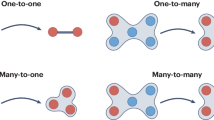Abstract
In this Chapter, we discuss the effects of higher-order structures on SIS-like processes of social contagion. After a brief motivational introduction where we illustrate the standard SIS process on networks and the difference between simple and complex contagions, we introduce spreading processes on higher-order structures starting from the most general formulation on hypergraphs and then moving to several mean-field and heterogeneous mean-field approaches. The results highlight the rich phenomenology brought by taking into account higher-order contagion effects: both continuous and discontinuous transitions are observed, and critical mass effects emerge. We conclude with a short discussion on the theoretical results regarding the nature of the epidemic transition and the general need for data to validate these models.
Access this chapter
Tax calculation will be finalised at checkout
Purchases are for personal use only
Similar content being viewed by others
Notes
- 1.
- 2.
For instance, the authors of [31] study the case in which \(\lambda _3 <0\), i.e., an individual is less likely to adopt a trend if this trend is popular in the group, and call this ingredient the "hipster effect"; this effect also can lead to a region of bi-stability in the phase diagram [31]. Note that heterogeneous recovery rates [43, 44] and “complex recovery” rates depending on the state of the surrounding individuals have also been considered in the literature [45].
References
R.M. Anderson, R.M. May, Infectious Diseases of Humans: Dynamics and Control (Oxford University Press, 1992)
M.J. Keeling, P. Rohani, Modeling Infectious Diseases in Humans and Animals (Princeton University Press, 2011)
R. Pastor-Satorras, A. Vespignani, Phys. Rev. Lett. 86(14), 3200 (2001)
A. Barrat, M. Barthelemy, A. Vespignani, Dynamical Processes on Complex Networks (Cambridge University Press, 2008)
R. Pastor-Satorras, C. Castellano, P. Van Mieghem, A. Vespignani, Rev. Mod. Phys. 87(3), 925 (2015)
I.Z. Kiss, J.C. Miller, P.L. Simon, et al., (Springer, Cham, 2017)
R. Albert, A.L. Barabási, Rev. Mod. Phys. 74(1), 47 (2002)
M.E.J. Newman, SIAM Rev. 45, 167 (2003)
D. Centola, M. Macy, Am. J. Sociol. 113(3), 702 (2007)
D. Centola, Science 329(5996), 1194 (2010)
J. Ugander, L. Backstrom, C. Marlow, J. Kleinberg, Pro. Natl. Acad Sci. U.S.A. 201116502 (2012)
L. Weng, A. Flammini, A. Vespignani, F. Menczer, Sci. Rep. 2, 335 (2012)
M. Karsai, G. Iniguez, K. Kaski, J. Kertész, J.R. Soc, Interface 11(101), 20140694 (2014)
B. Mønsted, P. Sapieżyński, E. Ferrara, S. Lehmann, PLoS One 12(9), e0184148 (2017)
D. Guilbeault, J. Becker, D. Centola, in Complex Spreading Phenomena in Social Systems (Springer, 2018), pp. 3–25
D.J. Watts, Proc. Natl. Acad. Sci. U.S.A. 99(9), 5766 (2002)
S. Melnik, J.A. Ward, J.P. Gleeson, M.A. Porter, Chaos 23(1), 013124 (2013)
Z. Ruan, G. Iniguez, M. Karsai, J. Kertész, Phys. Rev. Lett. 115(21), 218702 (2015)
A. Czaplicka, R. Toral, M. San Miguel, Phys. Rev. E 94(6), 062301 (2016)
E. Cozzo, R.A. Banos, S. Meloni, Y. Moreno, Phys. Rev. E 88(5), 050801 (2013)
N.O. Hodas, K. Lerman, Sci. Rep. 4, 4343 (2014)
M. Herrera, G. Armelini, E. Salvaj, PLoS One 10(10), e0140891 (2015)
D.J. O’Sullivan, G.J. O’Keeffe, P.G. Fennell, J.P. Gleeson, Front. Phys. 3, 71 (2015)
P. Tuzón, J. Fernández-Gracia, V.M. Eguíluz, Front. Phys. 6, 21 (2018)
F. Battiston, G. Cencetti, I. Iacopini, V. Latora, M. Lucas, A. Patania, J.G. Young, G. Petri, Phys. Rep. 874, 1 (2020)
I. Iacopini, G. Petri, A. Barrat, V. Latora, Nat. Commun. 10(1), 2485 (2019)
G.F. de Arruda, G. Petri, Y. Moreno, Phys. Rev. Res. 2(2), 023032 (2020)
B. Jhun, M. Jo, B. Kahng, J. Stat. Mech. Theory Exp. 2019(12), 123207 (2019)
J.T. Matamalas, S. Gómez, A. Arenas, Phys. Rev. Res. 2(1), 012049 (2020)
G.F. de Arruda, M. Tizzani, Y. Moreno, Commun. Phys. 4, 24 (2021)
N.W. Landry, J.G. Restrepo, Chaos 30(10), 103117 (2020)
D. Centola, J. Becker, D. Brackbill, A. Baronchelli, Science 360(6393), 1116 (2018)
A. Hatcherr, (2002)
M. Fernández, S. Williams, IEEE Trans. Aerosp. Electron. Syst. 46(2), 803 (2010)
G.F. de Arruda, F.A. Rodrigues, Y. Moreno, Phys. Rep. 756, 1 (2018)
O.T. Courtney, G. Bianconi, Phys. Rev. E 93(6), 062311 (2016)
J.G. Young, G. Petri, T.P. Peixoto, Commun. Phys. 4(1), 1 (2021)
M. Génois, C.L. Vestergaard, J. Fournet, A. Panisson, I. Bonmarin, A. Barrat, Netw. Sci. 3(3), 326 (2015)
L. Isella, J. Stehlé, A. Barrat, C. Cattuto, J.F. Pinton, W. Van den Broeck, J. Theor. Biol. 271(1), 166 (2011)
P. Vanhems, A. Barrat, C. Cattuto, J.F. Pinton, N. Khanafer, C. Régis, B.a. Kim, B. Comte, N. Voirin, PLoS One 8(9), e73970 (2013)
R. Mastrandrea, J. Fournet, A. Barrat, PLoS One 10(9), e0136497 (2015)
S. Battiston, J.B. Glattfelder, D. Garlaschelli, F. Lillo, G. Caldarelli, in Network Science (Springer, 2010), pp. 131–163
A. Darbon, D. Colombi, E. Valdano, L. Savini, A. Giovannini, V. Colizza, R. Soc. Open Sci. 6, 181404 (2019)
G.F. de Arruda, G. Petri, F.A. Rodrigues, Y. Moreno, Phys. Rev. Res. 2(1), 013046 (2020)
I. Iacopini, B. Schäfer, E. Arcaute, C. Beck, V. Latora, Chaos 30(1), 013153 (2020)
G. Petri, A. Barrat, Phys. Rev. Lett. 121(22), 228301 (2018)
L. Hébert-Dufresne, S.V. Scarpino, J.G. Young, Nat. Phys. 16, 426 (2020)
P. Sah, M. Otterstatter, S.T. Leu, S. Leviyang, S. Bansal, BioRxiv p. 169573 (2018)
D. Centola, A. Baronchelli, Proc. Natl. Acad. Sci. U.S.A. 112(7), 1989 (2015). https://doi.org/10.1073/pnas.1418838112
C. Gracia-Lázaro, A. Ferrer, G. Ruiz, A. Tarancón, J.A. Cuesta, A. Sánchez, Y. Moreno, Proc. Natl. Acad. Sci. U.S.A. 109(32), 12922 (2012)
Author information
Authors and Affiliations
Corresponding author
Editor information
Editors and Affiliations
Rights and permissions
Copyright information
© 2022 The Author(s), under exclusive license to Springer Nature Switzerland AG
About this chapter
Cite this chapter
Barrat, A., Ferraz de Arruda, G., Iacopini, I., Moreno, Y. (2022). Social Contagion on Higher-Order Structures. In: Battiston, F., Petri, G. (eds) Higher-Order Systems. Understanding Complex Systems. Springer, Cham. https://doi.org/10.1007/978-3-030-91374-8_13
Download citation
DOI: https://doi.org/10.1007/978-3-030-91374-8_13
Published:
Publisher Name: Springer, Cham
Print ISBN: 978-3-030-91373-1
Online ISBN: 978-3-030-91374-8
eBook Packages: Physics and AstronomyPhysics and Astronomy (R0)




